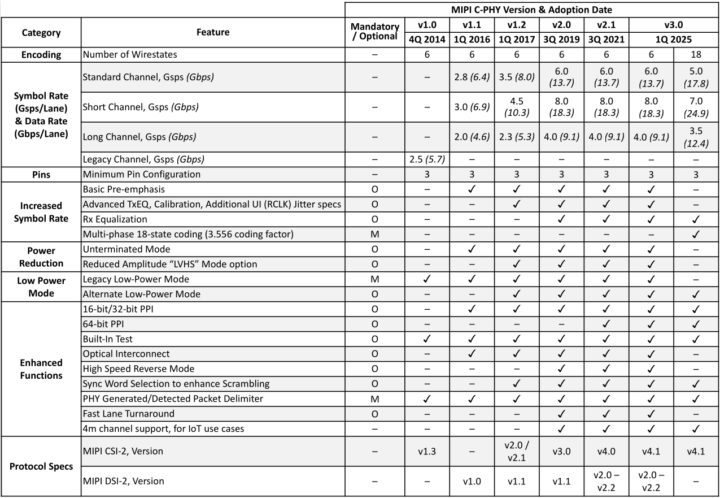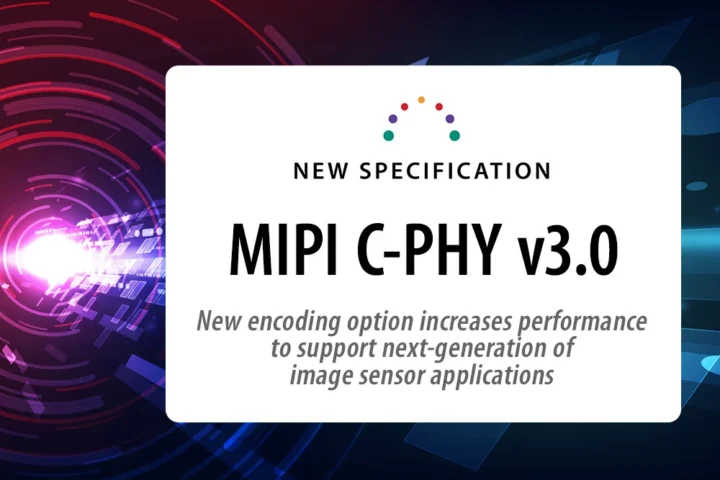The MIPI Alliance has recently released the MIPI C-PHY v3.0 specification, defining the physical layer for connecting cameras and displays. The main change in MIPI C-PHY Version 3.0 is the addition of an 18-Wirestate mode encoding option – instead of the 6-Wirestate mode encoding used in previous versions – that increases the maximum performance of a C-PHY lane by approximately 30 to 35 percent.
The MIPI Alliance claims this enhancement delivers up to 75 Gbps over a short channel for ultra-high-resolution image sensors. The table below shows the key features and differences between versions of the MIPI C-PHY specification.
Interestingly, the symbol rate decreased for MIPI C-PHY v3.0 compared to v2.1 (7.0 Gsps vs 8.0 Gsps for short channel), but the data rate increased from 18.3 to 24.9 Gbps, a 36% increase, due to the more efficient encoding option 32b9s that transports 32 bits over nine symbols (3.56 bits per symbol) while maintaining low EMI and low power properties.
I assume they came up with the 75 Gbps number by using three short channels. The new encoding will enable higher bandwidth for new use cases or lower symbol rate/lane count for existing use cases. The MIPI Alliance expects MIPI C-PHY v3.0 to be especially useful for applications such as:
- Prosumer video content creation on smartphones, with high dynamic range (HDR), smart region-of-interest detection, and advanced motion vector generation
- Optical inspection systems that can detect small defects in production lines
- Advanced driver assistance systems (ADAS) in automotive
I can also see that the new 18-Wirestate mode encoding lacks some of the features of the 6-Wirestate mode encoding related to increased symbol rate, power reduction, and legacy low power mode, but those are probably tradeoffs that had to be made for the improvements brought about by MIPI C-PHY v3.0.
We are also told that support for C-PHY v3.0 was included in the most recent MIPI CSI-2 v4.1 embedded camera and imaging interface specification published in April 2024. It’s counterintuitive that a new specification is added to an old one, but they address different parts (physical layer vs data protocol) and may be developed independently, and for instance, MIPI CSI-2 v4.1 could be compatible with future C-PHY specs. C-PHY v3.0 is also backward-compatible with previous C-PHY versions.
The MIPI Alliance also provides some forward guidance on upcoming MIPI D-PHY Updates. MIPI D-PHY v3.5 was released in 2023, and the upcoming v3.6 specification will expand the embedded clock support for camera applications used on PC / client computing platforms. Further ahead, MIPI D-PHY v4.0 will further expand embedded clock support for use in mobile and beyond-mobile machine vision applications with a data rate beyond its current 9 Gbps per lane.
The MIPI C-PHY v3.0 specification and related documentation can be found on the MIPI website, but it’s only accessible to members who pay a $4000 (or more) annual fee. The press release may also have a few more details.
Thanks to TLS for the tip.

Jean-Luc started CNX Software in 2010 as a part-time endeavor, before quitting his job as a software engineering manager, and starting to write daily news, and reviews full time later in 2011.
Support CNX Software! Donate via cryptocurrencies, become a Patron on Patreon, or purchase goods on Amazon or Aliexpress. We also use affiliate links in articles to earn commissions if you make a purchase after clicking on those links.





